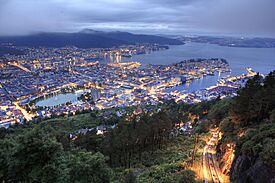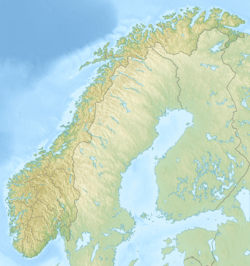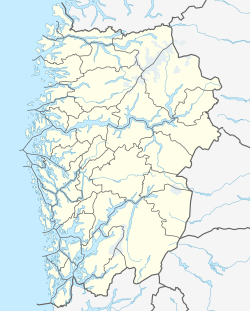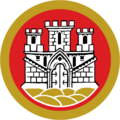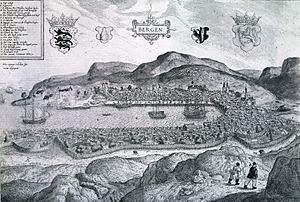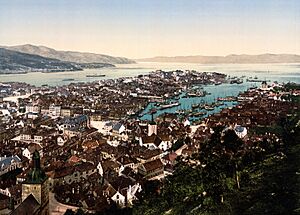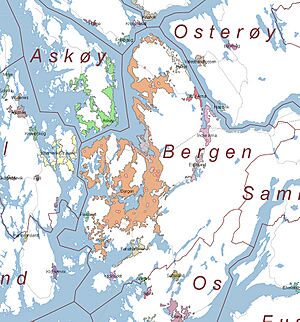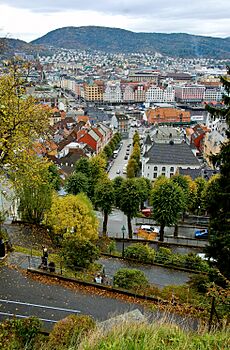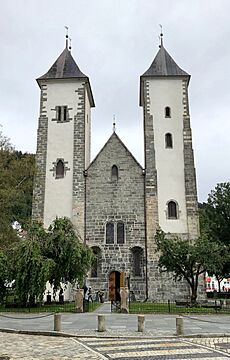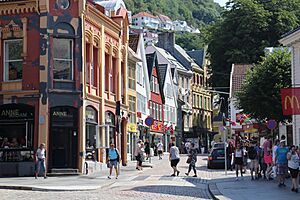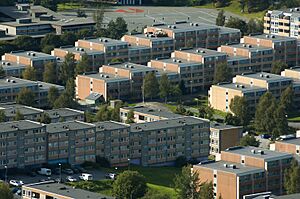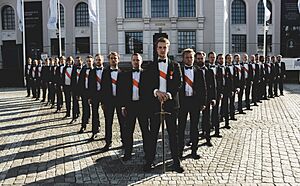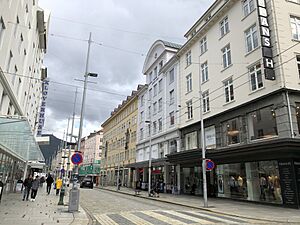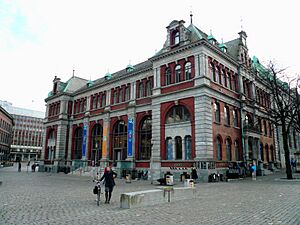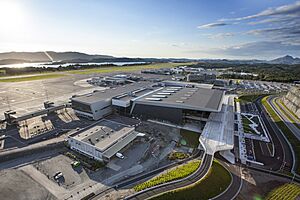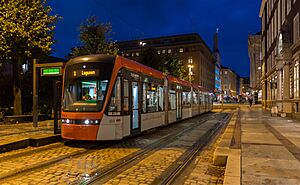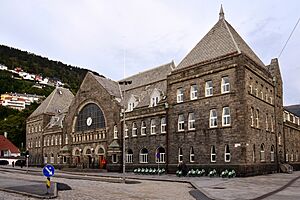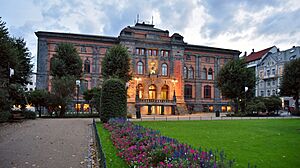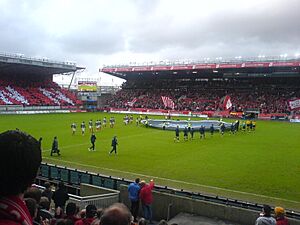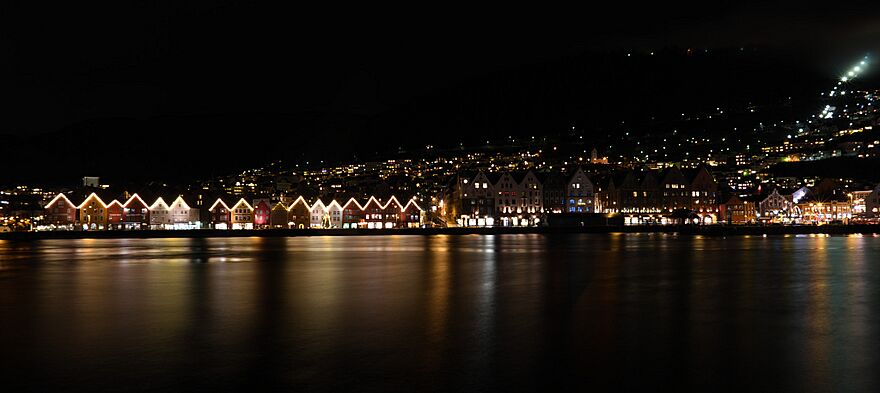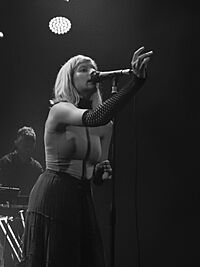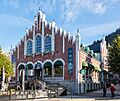Bergen facts for kids
Quick facts for kids
Bergen
|
||||||||||||||||||||||||||||||||||
|---|---|---|---|---|---|---|---|---|---|---|---|---|---|---|---|---|---|---|---|---|---|---|---|---|---|---|---|---|---|---|---|---|---|---|
|
City and municipality
|
||||||||||||||||||||||||||||||||||
|
||||||||||||||||||||||||||||||||||
| Country | ||||||||||||||||||||||||||||||||||
| Region | Western Norway | |||||||||||||||||||||||||||||||||
| County | Vestland | |||||||||||||||||||||||||||||||||
| District | Midhordland | |||||||||||||||||||||||||||||||||
| Municipality | Bergen | |||||||||||||||||||||||||||||||||
| Established | before 1070 | |||||||||||||||||||||||||||||||||
| Area | ||||||||||||||||||||||||||||||||||
| • City and municipality | 464.71 km2 (179.43 sq mi) | |||||||||||||||||||||||||||||||||
| • Land | 444.99 km2 (171.81 sq mi) | |||||||||||||||||||||||||||||||||
| • Water | 19.72 km2 (7.61 sq mi) 4.2% | |||||||||||||||||||||||||||||||||
| • Urban | 94.03 km2 (36.31 sq mi) | |||||||||||||||||||||||||||||||||
| • Metro | 2,755 km2 (1,064 sq mi) | |||||||||||||||||||||||||||||||||
| Highest elevation | 987 m (3,238 ft) | |||||||||||||||||||||||||||||||||
| Lowest elevation | 0 m (0 ft) | |||||||||||||||||||||||||||||||||
| Population
(1 January 2024)
|
||||||||||||||||||||||||||||||||||
| • City and municipality | 291,940 |
|||||||||||||||||||||||||||||||||
| • Metro | 469,238 |
|||||||||||||||||||||||||||||||||
| Demonym(s) | Bergenser/Bergensar | |||||||||||||||||||||||||||||||||
| GDP | ||||||||||||||||||||||||||||||||||
| • City and municipality | €36.569 billion (2021) | |||||||||||||||||||||||||||||||||
| Postal code |
5003–5268 (P.O.box 5802–5899)
|
|||||||||||||||||||||||||||||||||
| Area code(s) | (+47) 5556 | |||||||||||||||||||||||||||||||||
|
||||||||||||||||||||||||||||||||||
Bergen is a beautiful city and municipality on the west coast of Norway. It is located in Vestland county. As of 2022, about 289,330 people live here. Bergen is the second-largest city in Norway, after the capital, Oslo. The city is often called "the city of seven mountains" because it is surrounded by many hills.
Bergen has been an important trading hub since the 1020s. It was officially founded in 1070 by King Olav Kyrre. He named it Bjørgvin, which means 'the green meadow among the mountains'. Bergen was Norway's capital in the 1200s. Later, it became a major trading city for the Hanseatic League. This was a powerful group of merchant guilds. Until 1789, Bergen had special rights to control trade between northern Norway and other countries. It was the largest city in Norway until the 1830s. The old waterfront area, Bryggen, is now a World Heritage Site.
Today, Bergen is a global center for fish farming, shipping, and offshore oil and gas technology. It is also important for education, media, tourism, and finance in Norway. Bergen Port is Norway's busiest port. It welcomes over 300 cruise ships each year. This brings nearly half a million visitors to the city. Bergen's main football team is SK Brann. The city also has a unique tradition called buekorps, which are marching groups for young people. People from Bergen speak a special dialect called Bergensk. The city has its own airport, Bergen Airport, Flesland, and a light rail system.
Bergen has mild winters, even though it is quite far north. This is because of the Gulf Stream, which keeps the sea warm. The mountains around the city also protect it from cold winds. However, summers in Bergen are cooler than in Oslo due to these same ocean effects.
Contents
- History of Bergen
- Geography of Bergen
- Climate in Bergen
- People of Bergen
- Cityscape of Bergen
- Administration of Bergen
- Education in Bergen
- Economy of Bergen
- Transport in Bergen
- Culture and Sports in Bergen
- Media in Bergen
- Neighbourhoods of Bergen
- International Connections
- Twin Towns – Sister Cities
- Images for kids
- Notable people from Bergen
- See also
History of Bergen
Bergen was thought to be founded by King Olav Kyrre in 1070. This was four years after the Viking Age ended in England. However, newer studies show that people were already trading here in the 1020s or 1030s.
Bergen slowly became the capital of Norway in the early 1200s. It was the first city to have a basic central government. The city's main church hosted the first royal coronation in Norway in the 1150s. Bergenhus fortress was built in the 1240s to protect the harbor. Bergen stopped being the capital during King Haakon V's rule (1299–1319), when Oslo took over.
In the mid-1300s, German merchants set up one of their main trading posts in Bergen. This was part of the Hanseatic League. They mainly traded dried cod fish from northern Norway. This trade started around 1100. The city was given a special right to trade with northern Norway by King Håkon Håkonsson (1217–1263). Dried fish made Bergen one of the biggest trading centers in Northern Europe. By the late 1300s, Bergen was the main trading hub in Norway. The Hanseatic merchants lived in their own area of the city. They spoke Middle Low German. Today, Bergen's old waterfront, Bryggen, is a UNESCO World Heritage Site.
In 1349, the Black Death arrived in Norway on an English ship in Bergen. Later outbreaks happened in the 1600s. In the 1400s, the city was attacked several times. In 1429, attackers burned the royal castle and much of the city. In 1665, there was a sea battle in the harbor. An English fleet attacked Dutch ships, supported by Bergen's defenders. Many fires have also damaged the city over the years. A big fire in 1702 destroyed most of the town.
Through the 1400s and 1500s, Bergen was one of the largest cities in Scandinavia. It was Norway's biggest city until the 1830s. Around 1600, Norwegian merchants slowly took over the trade from the Hanseatic League. The Hanseatic trading post finally closed in the 1750s. Bergen kept its special trading rights with northern Norway until 1789. The Bergen stock exchange was set up in 1813.
Modern History of Bergen
Bergen became its own county in 1831. It was set up as a municipality in 1838. Some nearby rural areas joined Bergen later, in 1877 and 1915.
During World War II, German forces occupied Bergen on April 9, 1940. This happened after a short fight with Norwegian ships. On April 20, 1944, a Dutch cargo ship carrying explosives blew up near Bergenhus Fortress. This caused a lot of damage and loss of life. The city was also bombed by Allied forces, targeting German naval bases.
In 1972, the municipalities of Arna, Fana, Laksevåg, and Åsane joined Bergen. At this time, Bergen stopped being a separate county. It became a municipality within Vestland county.
Fires in Bergen's History
Bergen's history has many big fires.
- In 1198, a group called the Bagler set fire to the city during a civil war.
- In 1248, a fire destroyed 11 churches.
- In 1413, another fire destroyed 14 churches.
- In 1428, the city was robbed.
- In 1455, Hanseatic merchants burned down Munkeliv Abbey.
- In 1476, Bryggen burned down.
- In 1582, another fire hit the city center.
- In 1675, 105 buildings burned down.
- In 1686, a big fire destroyed 231 city blocks.
- The biggest fire was in 1702, when 90% of the city turned to ashes.
- In 1756, 1,500 buildings burned down.
- In 1916, 300 buildings in the city center burned, including Norway's oldest pharmacy.
- In 1955, parts of Bryggen burned again.
What's in a Name?
The name Bergen comes from the Old Norse words Bergvin or Bjǫrgvin. Berg or bjǫrg means 'mountain(s)'. Vin means 'a new settlement with a pasture or meadow'. So, the name means "the meadow among the mountains". This fits Bergen well, as it's known as "the city among the seven mountains". The writer Ludvig Holberg was inspired by Rome's seven hills and decided Bergen should have seven mountains too. People still debate which seven they are!
In 1918, there was a push to change the city's name back to Bjørgvin. This didn't happen, but as a compromise, the name of the local church area was changed to Bjørgvin bispedømme.
Geography of Bergen
Bergen is mostly located on the Bergenshalvøyen peninsula. The municipality covers about 465 square kilometers. Most of the city is near a fjord or bay. The city center is surrounded by the Seven Mountains. People don't always agree on which nine mountains count as the "seven". Ulriken, Fløyen, Løvstakken, and Damsgårdsfjellet are always included. Gullfjellet is Bergen's highest mountain, at 987 meters above sea level.
Bergen is protected from the North Sea by islands like Askøy and Sotra. Bergen shares borders with other municipalities to the north, east, south, and west.
Climate in Bergen
Bergen has an oceanic climate, meaning it has mild summers and cool winters. It rains a lot in all seasons. Snow falls in winter but often melts quickly. The large amount of rain is because of how the mountains affect the weather. This makes Bergen one of the rainiest cities in Europe.
Bergen's weather is much warmer than you might expect for how far north it is. Temperatures rarely drop below -10°C (14°F). Summer temperatures can reach the upper 20s °C (80s °F). The growing season for plants in Bergen is very long, over 200 days. This is thanks to the mild winters and the nearby Gulf Stream. The city is often cloudy throughout the year.
People of Bergen
| Historical population | ||
|---|---|---|
| Year | Pop. | ±% |
| 1500 | 5,500 | — |
| 1769 | 18,827 | +242.3% |
| 1855 | 37,015 | +96.6% |
| 1900 | 94,485 | +155.3% |
| 1910 | 104,224 | +10.3% |
| 1920 | 118,490 | +13.7% |
| 1930 | 129,118 | +9.0% |
| 1940 | — | |
| 1950 | 162,381 | — |
| 1960 | 185,822 | +14.4% |
| 1970 | 209,066 | +12.5% |
| 1980 | 207,674 | −0.7% |
| 1990 | 212,944 | +2.5% |
| 2000 | 229,496 | +7.8% |
| 2010 | 256,580 | +11.8% |
| 2014 | 271,949 | +6.0% |
| 2016 | 278,121 | +2.3% |
| 2022 | 289,330 | +4.0% |
| Source: Statistics Norway. Note: The municipalities of Arna, Fana, Laksevåg and Åsane were merged with Bergen 1 January 1972. | ||
As of early 2022, Bergen had a population of 289,330 people. This means there are about 599 people per square kilometer. Most people live in urban areas.
Bergen is a diverse city. As of 2007, about 84.5% of residents had two parents born in Norway. The rest were immigrants or had immigrant backgrounds from various countries. The population has been growing steadily. In 2009, it grew by 4,549 people.
The number of people with immigrant backgrounds in Bergen has increased a lot since 1993. In 2014, about 15.5% of the city's population had backgrounds from over 200 countries. Many of these came from Europe, Asia, and Africa.
The Church of Norway is the largest religious group in Bergen. About 79.74% of people were registered members in 2012. Bergen is home to the Diocese of Bjørgvin, with Bergen Cathedral as its main church. Other groups include those with no religion, various Protestant churches, Catholics, and Muslims.
Cityscape of Bergen
| UNESCO World Heritage Site | |
|---|---|

Bryggen in Bergen, built after 1702
|
|
| Location | Bergen Municipality, Bergen, Norway |
| Criteria | Cultural: (iii) |
| Inscription | 1979 (3rd Session) |
| Area | 1.196 ha (128,700 sq ft) |
The center of Bergen is in the west of the municipality. It faces the Byfjorden fjord. The city is surrounded by mountains. From the center, the city spreads north, west, and south. To the east, there is a large mountain area. Outside the city center, most people live in less crowded neighborhoods built after 1950. Some areas have many apartment buildings, while others have mostly single-family homes.
The oldest part of Bergen is around the bay of Vågen in the city center. Few very old buildings remain. The most important is St Mary's Church from the 1100s. In 1702, a fire burned down most of the city. Many of Bergen's old buildings, including Bryggen, were rebuilt after this fire. This fire also led to a change from tar-covered or log houses to painted wooden buildings and some brick ones.
In the late 1800s, Bergen grew quickly and became more modern. After a fire in 1855, new city blocks were built in the center. The city limits expanded in 1876. Areas like Nygård and Møhlenpris became urbanized. Many new buildings were constructed for both rich and poor people. Their style was influenced by different art movements. Wealthy people built villas on the side of Mount Fløyen.
After Årstad joined Bergen in 1916, new plans for development were made. Many workers built their own homes. After World War II, Bergen needed more land for building. Many large apartment buildings were built in Landås in the 1950s and 1960s. Bergen also gained Fyllingsdalen in 1955. This area was developed into a modern suburb with large apartment buildings and some single-family homes.
As Bergen expanded, its suburbs also grew fast. Many wealthy citizens moved to areas like Fana, Åsane, and Laksevåg. Most homes in these areas are detached houses or small apartment buildings. After the surrounding areas joined Bergen in 1972, growth continued in a similar way. The city now encourages building more homes near shops and future Bergen Light Rail stations.
Some old buildings and neighborhoods have been torn down for new development. However, plans to demolish entire areas like Marken were stopped. After the 1955 fire, Bryggen was almost demolished. Instead, the remaining buildings were restored, and some burned ones were rebuilt to look like the originals.
Administration of Bergen
Bergen has had a parliamentary government since 2000. Before that, it was run by the city council. The government now has seven members called commissioners. These commissioners are chosen by the city council, which is the main authority in the city.
Boroughs of Bergen
Bergen is divided into eight main areas called boroughs. Starting from the north and going clockwise, they are Åsane, Arna, Fana, Ytrebygda, Fyllingsdalen, Laksevåg, Årstad, and Bergenhus. The city center is located in Bergenhus. Some parts of Fana, Ytrebygda, Åsane, and Arna are not part of the main urban area. This is why the municipality has about 20,000 more people than the urban area.
| Borough | Population | % | Area (km2) | % | Density (/km2) |
|---|---|---|---|---|---|
| Arna | 14,020 | 4.9 | 102.44 | 22.0 | 123 |
| Bergenhus1 | 43,218 | 14.8 | 26.58 | 5.7 | 4.415 |
| Fana | 44,600 | 14.8 | 159.70 | 34.3 | 239 |
| Fyllingsdalen | 30,614 | 11.1 | 18.84 | 4.0 | 1.530 |
| Laksevåg | 40,646 | 14.8 | 32.72 | 7.0 | 1.173 |
| Ytrebygda | 31,676 | 9.9 | 39.61 | 8.5 | 649 |
| Årstad2 | 42,673 | 14.5 | 14.78 | 3.2 | 4.440 |
| Åsane | 44,233 | 15.2 | 71.01 | 15.2 | 556 |
| Not stated | 260 | ||||
| Total | 291,940 | 100 | 465.68 | 100 | 559 |
(Pertaining to the table above: The acreage figures include fresh water and uninhabited mountain areas, except:
1 1 The borough Bergenhus is 8.73 km2, the rest is water and uninhabited mountain areas.
2 2 The borough Årstad is 8.47 km2, the rest is water and uninhabited mountain areas.)
Education in Bergen
Bergen has many schools. There are 64 elementary schools, 18 lower secondary schools, and 20 upper secondary schools. Also, there are 11 schools that combine elementary and lower secondary levels. Bergen Cathedral School is the oldest school in Bergen. It was founded in 1153 by Pope Adrian IV.
Important educational institutions were established in Bergen over time. The "Bergen School of Meteorology" started in 1917. The Norwegian School of Economics was founded in 1936. The University of Bergen opened in 1946.
The University of Bergen has 16,000 students and 3,000 staff. It is the third-largest educational place in Norway. Research began at Bergen Museum in 1825. The university offers many courses and does research in areas like climate and petroleum. Its main campus is in the city center.
The Western Norway University of Applied Sciences has its main campus in Kronstad. It has 16,000 students and 1,800 staff. It focuses on training for jobs like teaching, healthcare, and engineering. The Norwegian School of Economics is a top business school in Norway. It has over 3,000 students. Other schools include the Bergen School of Architecture and the Bergen National Academy of the Arts. The Norwegian Institute of Marine Research is also in Bergen. It studies oceans and fish farming.
Economy of Bergen
In 2004, Time magazine called Bergen one of Europe's "secret capitals." This is because Bergen is a leader in ocean-related businesses. These include fish farming and marine research. The Institute of Marine Research (IMR) is a top research center here. Some of the world's biggest fish farming companies, like Mowi and Lerøy, have their main offices in Bergen.
Bergen is also very important for shipping. Many shipowners based in Bergen control a large part of Norway's merchant ships. The city also has many financial companies and banks.
Bergen is the main base for the Royal Norwegian Navy at Haakonsvern. Its airport, Flesland, is the main helicopter base for Norway's North Sea oil and gas industry. Thousands of workers travel from here to oil rigs.
Tourism is a big part of Bergen's economy. Many tourists and conferences visit the city. Bergen is known as the unofficial capital of Western Norway. It is also called the "gateway city" to Norway's famous fjords. This makes it Norway's largest cruise ship port.
Transport in Bergen
Bergen Airport, Flesland is about 18 kilometers from the city center. In 2013, it served 6 million passengers. It is a hub for several airlines. You can fly directly to 20 places in Norway and 53 international destinations. Bergen Port is Norway's largest seaport. In 2011, it had 264 cruise ship visits.
Fjord Line offers ferry services to Hirtshals, Denmark. Bergen is also the starting point for Hurtigruten, the Coastal Express. This ship travels daily along the coast to Kirkenes. Passenger catamarans also run from Bergen to other towns.
The city center has an electronic toll system for cars. The main roads include E39 (north-south) and E16 (east). There are four major bridges connecting Bergen to nearby areas. These include the Nordhordland Bridge and the Askøy Bridge. Bergen is also connected to the island of Bjorøy by an underwater tunnel.
Bergen Station is the end point of the Bergen Line. This railway runs 496 kilometers to Oslo. Trains run frequently between Bergen and Arna Station.
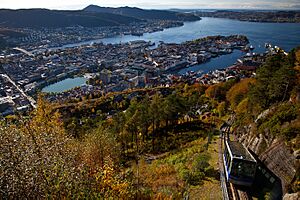
Bergen is one of the few cities in Europe with both tram and trolleybus systems. Public transport is managed by Skyss. They run a large bus network. The trolleybus system is the only one still working in Norway.
The modern Bergen Light Rail (Bybanen) opened in 2010. It connects the city center to Nesttun. It was extended to Rådal in 2013 and to Bergen Airport in 2017. There are plans to extend it to other boroughs. Fløibanen is a funicular that takes you from the city center up Mount Fløyen. Ulriksbanen is an aerial tramway that goes up Mount Ulriken.
Culture and Sports in Bergen
Bergens Tidende (BT) and Bergensavisen (BA) are the biggest newspapers in Bergen. BT covers all of Vestland, while BA focuses on Bergen itself. TV 2, Norway's largest private TV company, is based in Bergen.
The Grieg Hall is Bergen's main cultural place. It has 1,500 seats. It is home to the Bergen Philharmonic Orchestra, which started in 1765. The city also has Carte Blanche, Norway's national modern dance company. The yearly Bergen International Festival is the main cultural event. The Bergen International Film Festival also takes place here. Two famous composers from Bergen are Edvard Grieg and Ole Bull. Grieg's home, Troldhaugen, is now a museum. In the 1990s and early 2000s, Bergen became known for its pop, rock, and black metal music, called the Bergen Wave.
Den Nationale Scene is Bergen's main theater. It was founded in 1850. Famous writer Henrik Ibsen worked there early in his career. Bergen was a European Capital of Culture in 2000. Buekorps are a special part of Bergen's culture. They are groups of boys, aged 7 to 21, who parade with toy weapons and drums. The Hanseatic Museum at Bryggen shows the city's trading history.
SK Brann is Bergen's top football team. They have played in Norway's top league for many years. They won the football championship in 1961–1962, 1963, and 2007. They also won the Norwegian Football Cup seven times. Brann plays their home games at Brann Stadion. Åsane is another football team in the city. Women's teams like Brann and Arna-Bjørnar also play in the top league.
Bergensk is the local dialect of Bergen. It was greatly influenced by German merchants from the mid-1300s to the mid-1700s. During the time Norway was part of Denmark, the dialect was also influenced by Danish. This caused the female grammatical gender to disappear in the 1500s. So, Bergensk is one of the few Norwegian dialects with only two genders. The "R" sound in Bergensk is like the French "R". This probably spread to Bergen in the 1700s.
Bergen hosted the Eurovision Song Contest in 1986. It also hosted the 2017 UCI Road World Championships for cycling. Since 2015, Bergen has been part of the UNESCO Creative Cities Network for its food culture.
Music in Bergen
Bergen has been home to many famous bands and artists. These include Röyksopp and Kings of Convenience, part of what's called the Bergen Wave. Other well-known artists from Bergen are Aurora, Sondre Lerche, Kygo, Boy Pablo, and Alan Walker. Bergen is also known as the "black metal capital of Norway" because many black metal bands started here in the early 1990s. The singer Einar Selvik from the band Wardruna was born in Bergen. He became famous for his music in the TV series Vikings.
Bergen is also the birthplace of the famous composer Edvard Grieg.
Street Art in Bergen
Bergen is seen as the street art capital of Norway. The famous artist Banksy visited in 2000. This inspired many local artists to start creating street art. Soon after, Dolk became Norway's most famous street artist. You can still see his art in Bergen. In 2009, the city council decided to protect Dolk's work "Spray" with glass. In 2011, Bergen's council made a plan to support street art. They wanted Bergen to be a leader in street art in Norway and Scandinavia.
The Madam Felle monument in Sandviken honors a Norwegian woman of German origin. In the mid-1800s, she managed to keep selling beer against the city's wishes. A well-known restaurant in Bergen is named after her. The monument was put up in 1990. Madam Felle was also remembered in a popular song.
Media in Bergen
Newspapers
- Fjordaposten (1923–1940)
- Bergens Tidende (1868-)
- Bergensavisen (1927-)
Neighbourhoods of Bergen
Some of Bergen's traditional neighborhoods include Bryggen, Eidemarken, Engen, Fjellet, Kalfaret, Ladegården, Løvstakksiden, Marken, Minde, Møhlenpris, Nordnes, Nygård, Nøstet, Sandviken, Sentrum, Skansen, Skuteviken, Strandsiden, Stølen, Sydnes, Verftet, Vågsbunnen, Wergeland, and Ytre Sandviken.
International Connections
Bergen has special friendships with cities around the world. Each year, Bergen sends a Christmas tree to Newcastle's Haymarket in England. This shows the ongoing friendship between the two cities. Bergen also takes part in inter-Nordic camps with its friendship cities: Gothenburg (Sweden), Turku (Finland), and Aarhus (Denmark). In 1970, Bergen received a totem pole from Seattle, USA, as a gift for its 900th anniversary. It stands in Nordnes Park, looking out towards its friendship city across the sea.
Twin Towns – Sister Cities
Bergen is twinned with:
 Aarhus, Denmark (since 1946)
Aarhus, Denmark (since 1946) Gothenburg, Sweden (since 1946)
Gothenburg, Sweden (since 1946) Newcastle, England, United Kingdom (since 1968)
Newcastle, England, United Kingdom (since 1968) Rostock, Germany (since 1957)
Rostock, Germany (since 1957) Seattle, United States (since 1967)
Seattle, United States (since 1967) Turku, Finland (since 1946)
Turku, Finland (since 1946)
Images for kids
Notable people from Bergen
- List of people from Bergen
See also
 In Spanish: Bergen para niños
In Spanish: Bergen para niños


